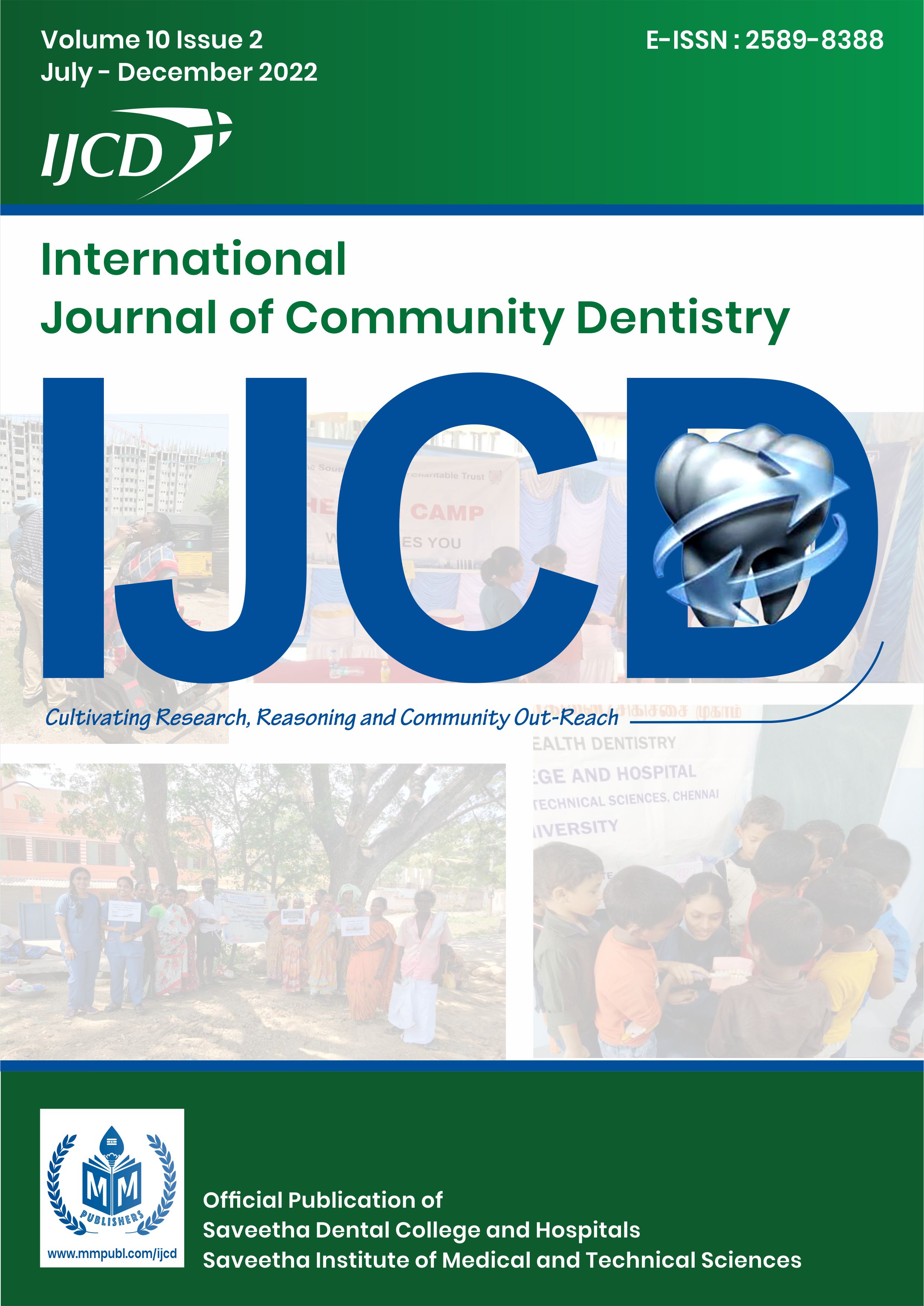IMPACT OF BAKING SODA ON TEETH WHITENING AMONG TOBACCO USERS - AN INTERVENTIONAL STUDY
Original Research
DOI:
https://doi.org/10.56501/intjcommunitydent.v10i2.568Keywords:
Tobacco users; Whitening of teeth; Oral health; Baking sodaAbstract
Background:
A more stylish and wonderful grin has been a typical longing for a great many people looking for dental treatment. Tooth tint is considered as a fundamental factor in the dental charisma, especially in the front upper dentition. Tooth staining might be brought about by inherent or outward stain or a blend of tooth. Baking soda is the successful and simple strategy to improve brightening of teeth. As a decisive assurance of the nurse, it is one of responsibility to dealing with the patient's consideration to survey the oral mucosa and settle on resulting techniques for oral cleanliness and improving teeth brightening.
Methods and methodology:
The present study aims to assess the effectiveness of baking soda on whitening of teeth among tobacco users. A quantitative quasi experimental research design was conducted among 60 tobacco users. Purposive sampling technique was used to select samples. Semi-structured interview was used to collect demographic data and teeth whitening was assessed using Modified Lobene Stain Index. The tobacco users in experimental group were given baking soda to brush the teeth two minutes per day. After one week, the tooth was re-assessed.
Results:
The study results show significant improvement in the teeth whitening among experimental group than control group after the intervention at the level of p<0.001.
Conclusion:
This reveals that baking soda is highly significant in the experimental group because it improves teeth whitening of the tobacco users. This indicates that baking soda is the effective and easy method to improve teeth whitening.
References
Bruno G. S. Casado, Sandra L. D. Moraes, Gleicy F. M. Souza, Catia M. F. Guerra, Juliana R. Souto-Maior, Cleidiel A. A. Lemos, Belmiro C. E. Vasconcelos, Eduardo P. Pellizzer, "Efficacy of Dental Bleaching with Whitening Dentifrices: A Systematic Review", International Journal of Dentistry, vol. 2018, ArticleID 7868531, 8 pages, 2018. https://doi.org/10.1155/2018/7868531
Bersezio, C., Martín, J., Herrera, A. et al. (2018) The effects of at-home whitening on patients’ oral health, psychology, and aesthetic perception. BMC Oral Health 18, 208. https://doi.org/10.1186/s12903-018-0668-2
Bernardon, J. K., Sartori, N., Ballarin, A., Perdigão, J., Lopes, G. C., &Baratieri, L. N. (2010). Clinical performance of vital bleaching techniques. Operative dentistry, 35(1), 3–10. https://doi.org/10.2341/09-008CR
Ahrari, F., Hasanzadeh, N., Rajabi, O., &Forouzannejad, Z. (2017). Effectiveness of sodium bicarbonate combined with hydrogen peroxide and CPP-ACPF in whitening and microhardness of enamel. Journal of clinical and experimental dentistry, 9(3), e344–e350. https://doi.org/10.4317/jced.53108
Çakmakçıoğlu, Özcan& Yilmaz Atali, Pinar &Topbaşı, Faik. (2009). Clinical evaluation of whitening effect of whitening toothpastes: A pilot study. OHDMBSC. 3. 6-13.
G., S., Karuppaiah, M., Garla, B. K., M., T., & Pandian, P. (2019). Effect of Whitening Toothpastes on Extrinsic Dental Stains. Journal of Advanced Oral Research, 10(1), 19–23. https://doi.org/10.1177/2320206819834411
Ghanbarzadeh, M., Ahrari, F., Akbari, M., &Hamzei, H. (2015). Microhardness of demineralized enamel following home bleaching and laser-assisted in office bleaching. Journal of clinical and experimental dentistry, 7(3), e405–e409. https://doi.org/10.4317/jced.51705
Kugel, G., Perry, R. D., Hoang, E., & Scherer, W. (1997). Effective tooth bleaching in 5 days: using a combined in-office and at-home bleaching system. Compendium of continuing education in dentistry (Jamesburg, N.J.: 1995), 18(4), 378–383.
Li Y. (2017). Stain removal and whitening by baking soda dentifrice: A review of literature. Journal of the American Dental Association (1939), 148(11S), S20–S26. https://doi.org/10.1016/j.adaj.2017.09.006
Li, Y., Liang, C., Slemenda, C. W., Ji, R., Sun, S., Cao, J., Emsley, C. L., Ma, F., Wu, Y., Ying, P., Zhang, Y., Gao, S., Zhang, W., Katz, B. P., Niu, S., Cao, S., &Johnston, C. C., Jr (2001). Effect of long-term exposure to fluoride in drinking water on risks of bone fractures. Journal of bone and mineral research: the official journal of the American Society for Bone and Mineral Research, 16(5), 932–939. https://doi.org/10.1359/jbmr.2001.16.5.932.
Priyadarsini.A & Sugantha (2020) Effectiveness of crushed bay leaves in removing dental plaque among tobacco chewers. Drug Invention Today.14 (7): 1240 – 1244.
Soparkar, P., & Newman, M. B. (2001). Effects of a Baking Soda Gum on extrinsic dental stain: results of a longitudinal 4-week assessment. Compendium of continuing education in dentistry (Jamesburg, N.J.: 1995), 22(7A), 25–28.
Soeteman, G. D., Valkenburg, C., Van der Weijden, G. A., Van Loveren, C., Bakker, E., & Slot, D. E. (2018). Whitening dentifrice and tooth surface discoloration-a systematic review and meta-analysis. International journal of dental hygiene, 16(1), 24–35. https://doi.org/10.1111/idh.12289
Ghassemi, A., Hooper, W., Vorwerk, L., Domke, T., DeSciscio, P., &Nathoo, S. (2012). Effectiveness of a new dentifrice with baking soda and peroxide in removing extrinsic stain and whitening teeth. The Journal of clinical dentistry, 23(3), 86–91.

Downloads
Published
How to Cite
Issue
Section
License
Copyright (c) 2022 Jagadeeswari J, Shalini T

This work is licensed under a Creative Commons Attribution-NonCommercial 4.0 International License.



